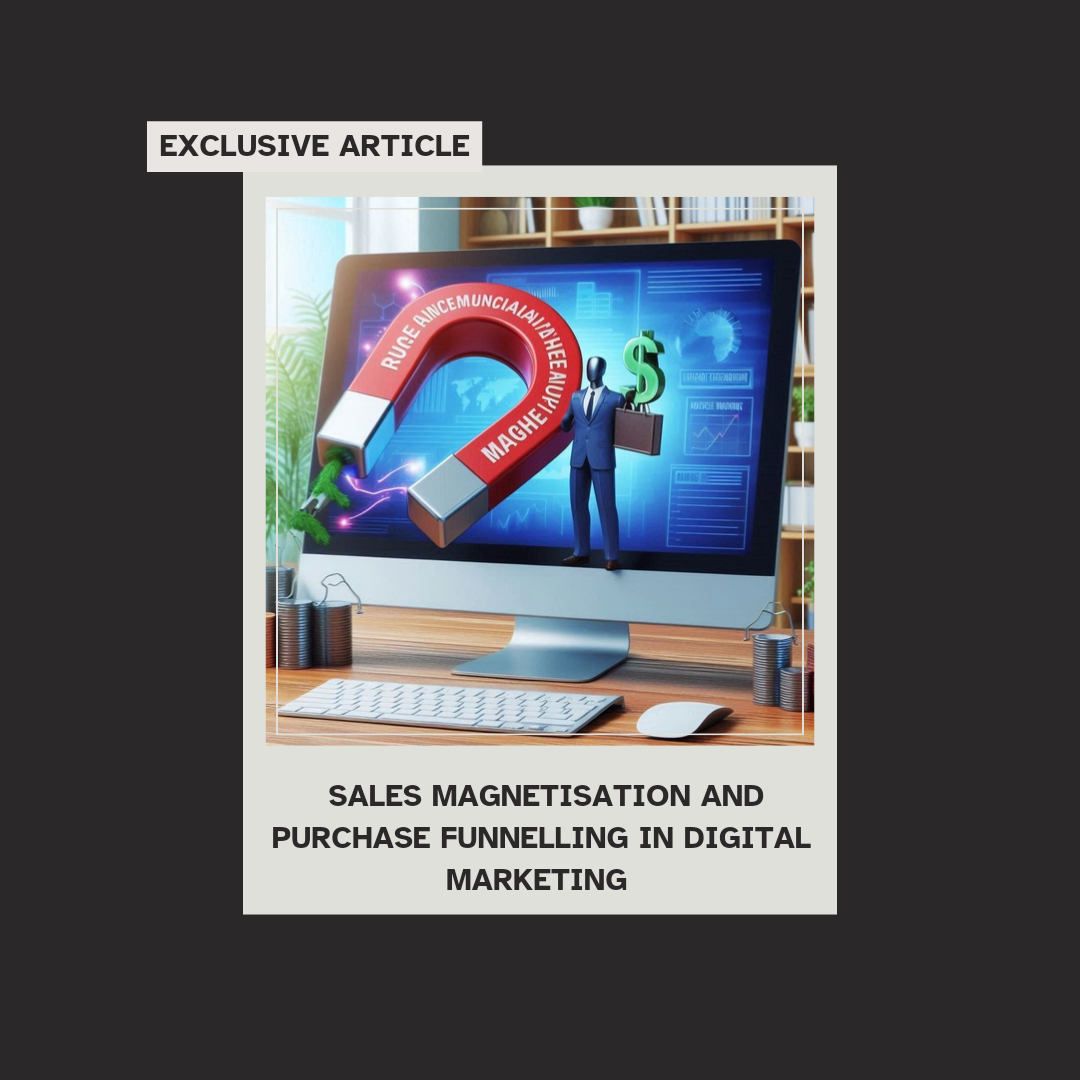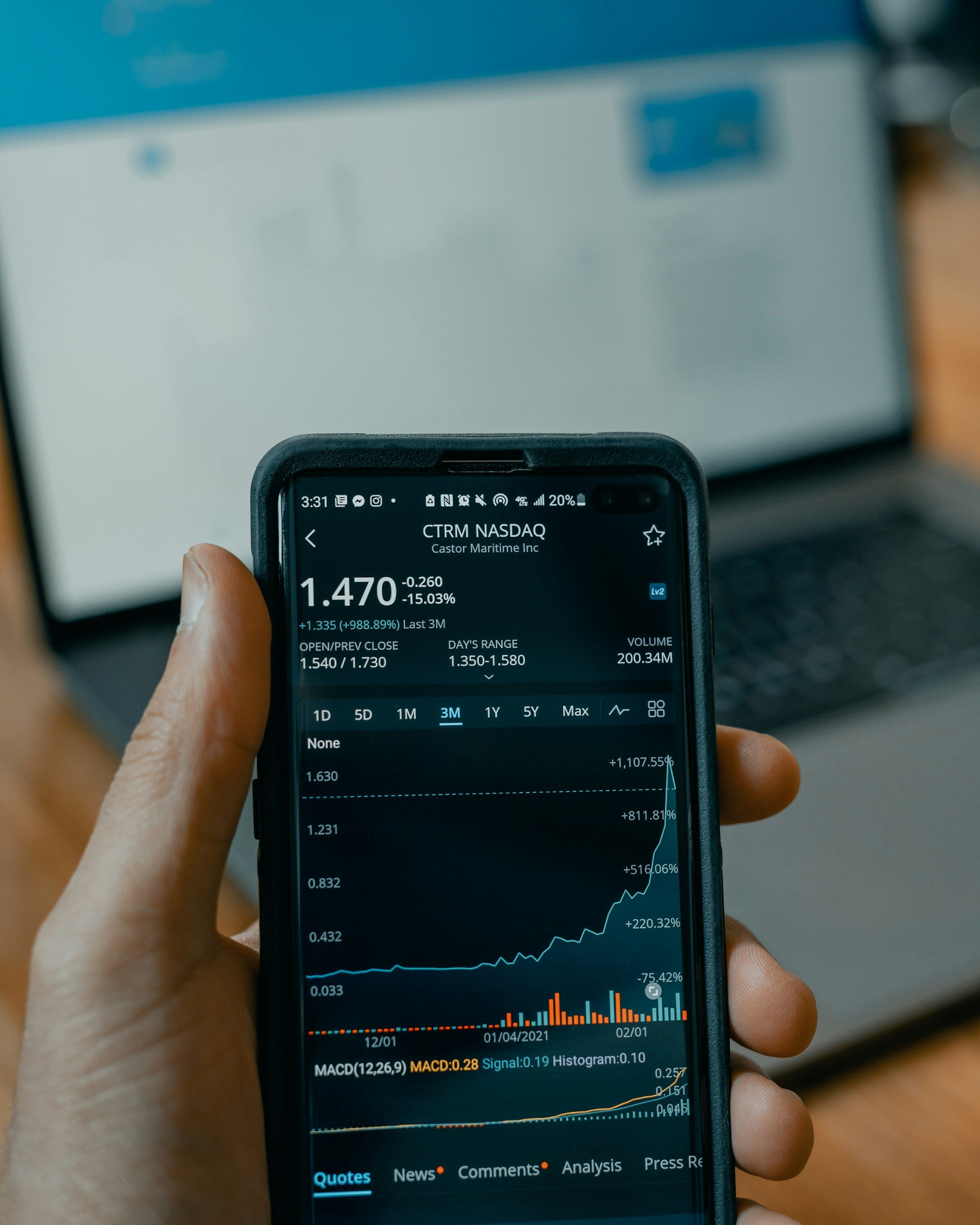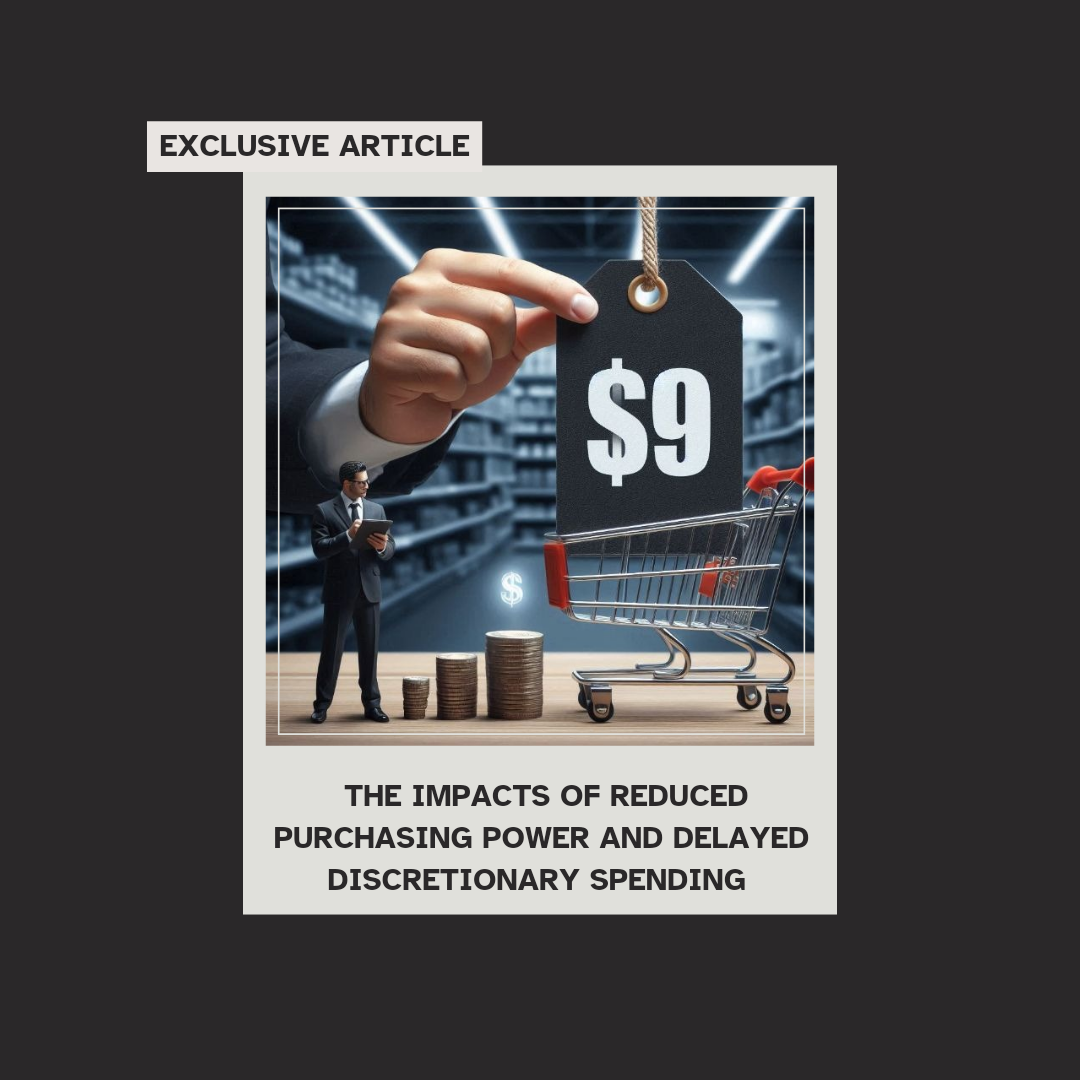Articles
Business and the Economy
EXCLUSIVE
ARTICLES
Make an impact today
Support my free content by contributing a donation.

How Weak Consumer Purchasing Power Impacts Controlled Economic Growth
Weak consumer purchasing power significantly hinders controlled economic growth by limiting overall demand for goods and services. When consumers have less disposable income, their ability to spend diminishes, leading to decreased consumption. This reduction in aggregate demand can create a ripple effect across various sectors of the economy, affecting businesses' revenues and growth projections.
For businesses, lower sales volumes can result in reduced profitability, prompting them to scale back investment in expansion or hiring. This stagnation can further exacerbate unemployment rates, creating a cycle where the lack of employment perpetuates weak purchasing power. Consequently, businesses may struggle to innovate or improve efficiency, hampering the overall economic dynamism that is necessary for controlled growth.
Moreover, government strategies aimed at stimulating economic activity through fiscal measures may prove less effective in an environment characterised by weak consumer spending. Policymakers often rely on increasing consumer confidence as a catalyst for growth; however, when purchasing power is compromised, even well-designed fiscal policies may fail to yield the desired outcomes. In this context, a stagnant or declining economy can ensue, where efforts to stimulate growth are repeatedly thwarted by persistent issues in consumer spending capabilities.
To address this challenge, it is essential for stakeholders to identify and implement measures that enhance purchasing power, such as wage growth initiatives, tax reforms, and strategic investments in social infrastructure. By fostering an environment where consumers feel financially secure, both businesses and policymakers can work towards a more vibrant economy that supports sustainable growth.

The Impact of Sustained Economic Growth, Business Expansion, and Discretionary Marketing in an Online Enterprise
Sustained economic growth plays a pivotal role in shaping the landscape of online enterprises. When an economy is prospering, disposable income rises, leading to increased consumer spending. This shift enables online businesses to expand their operations, diversify their offerings, and invest in marketing strategies that leverage the heightened purchasing power of consumers.
In an environment characterised by sustained economic growth, businesses are often encouraged to scale their operations. This may involve expanding product lines, exploring new markets, or enhancing technological capabilities. For online enterprises, these expansions allow them to meet the growing demands of a more affluent customer base, positioning themselves as competitive players in a crowded marketplace.
Furthermore, the concept of discretionary marketing becomes increasingly significant during periods of economic prosperity. With more funds available for marketing initiatives, businesses are empowered to adopt innovative digital strategies, such as influencer collaborations, targeted social media campaigns, and advanced data analytics. This enables them to engage with consumers in a more personalised manner, enhancing brand loyalty and driving repeat sales.
However, it is crucial for businesses to approach expansion and marketing with a strategic mindset. While growth can provide opportunities, it also carries risks, including overextension and market saturation. Thus, careful analysis and planning are essential to ensure that the benefits of sustained economic growth are maximised without compromising the integrity of the online enterprise. The interplay of these factors underscores the importance of a rigorous approach to management and a keen understanding of market dynamics as businesses navigate the evolving economic landscape.
Sustained economic growth plays a pivotal role in shaping the landscape of online enterprises. When an economy is prospering, disposable income rises, leading to increased consumer spending. This shift enables online businesses to expand their operations, diversify their offerings, and invest in marketing strategies that leverage the heightened purchasing power of consumers.
In an environment characterised by sustained economic growth, businesses are often encouraged to scale their operations. This may involve expanding product lines, exploring new markets, or enhancing technological capabilities. For online enterprises, these expansions allow them to meet the growing demands of a more affluent customer base, positioning themselves as competitive players in a crowded marketplace.
Furthermore, the concept of discretionary marketing becomes increasingly significant during periods of economic prosperity. With more funds available for marketing initiatives, businesses are empowered to adopt innovative digital strategies, such as influencer collaborations, targeted social media campaigns, and advanced data analytics. This enables them to engage with consumers in a more personalised manner, enhancing brand loyalty and driving repeat sales.
However, it is crucial for businesses to approach expansion and marketing with a strategic mindset. While growth can provide opportunities, it also carries risks, including overextension and market saturation. Thus, careful analysis and planning are essential to ensure that the benefits of sustained economic growth are maximised without compromising the integrity of the online enterprise. The interplay of these factors underscores the importance of a rigorous approach to management and a keen understanding of market dynamics as businesses navigate

How To Optimize and Identify Behavioral Changes and Industrial Trends in Online Marketing
In the evolving landscape of online marketing, understanding and optimizing behavioral changes and industrial trends is critical for businesses aiming to maintain competitive advantage. A systematic approach to identifying these behavioral shifts begins with robust data analytics. Utilizing tools such as Google Analytics, social media insights, and customer feedback can provide invaluable information on user interactions and preferences.
Businesses should focus on analyzing engagement metrics, such as click-through rates and time spent on site, to detect subtle changes in consumer behavior. Segmenting audiences based on demographics, purchasing patterns, and engagement levels allows marketers to tailor their strategies accordingly.
Simultaneously, staying attuned to industry trends, such as shifts towards sustainability or increased demand for personalized marketing, is essential. Regularly reviewing market research reports and competitor analysis can help identify these trends early. Engaging in continuous learning through webinars, industry conferences, and networking with peers enables marketers to remain agile in a rapidly changing environment.
Implementing A/B testing for marketing campaigns fosters a culture of experimentation. Marketers can compare different versions of content or ads to determine which resonates better with their audience. This iterative process not only refines current strategies but also uncovers potential emerging trends dictated by consumer preferences.
Finally, leveraging customer relationship management (CRM) systems can enhance a company’s ability to predict behavioral changes through the analysis of historical data. By integrating insights gathered from various touchpoints, businesses can create a holistic view of the customer journey, enabling them to adapt and optimize their marketing efforts proactively.
In summary, the successful optimization and identification of behavioral changes and industrial trends in online marketing hinges on a combination of data analysis, industry research, audience segmentation, and a willingness to iterate and innovate based on real-time feedback and performance
In the evolving landscape of online marketing, understanding and optimizing behavioral changes and industrial trends is critical for businesses aiming to maintain competitive advantage. A systematic approach to identifying these behavioral shifts begins with robust data analytics. Utilizing tools such as Google Analytics, social media insights, and customer feedback can provide invaluable information on user interactions and preferences.
Businesses should focus on analyzing engagement metrics, such as click-through rates and time spent on site, to detect subtle changes in consumer behavior. Segmenting audiences based on demographics, purchasing patterns, and engagement levels allows marketers to tailor their strategies accordingly.
Simultaneously, staying attuned to industry trends, such as shifts towards sustainability or increased demand for personalized marketing, is essential. Regularly reviewing market research reports and competitor analysis can help identify these trends early. Engaging in continuous learning through webinars, industry conferences, and networking with peers enables marketers to remain agile in a rapidly changing environment.
Implementing A/B testing for marketing campaigns fosters a culture of experimentation. Marketers can compare different versions of content or ads to determine which resonates better with their audience. This iterative process not only refines current strategies but also uncovers potential emerging trends dictated by consumer preferences.
Finally, leveraging customer relationship management (CRM) systems can enhance a company’s ability to predict behavioural changes through the analysis of historical data. By integrating insights gathered from various touchpoints, businesses can create a holistic view of the customer journey, enabling them to adapt and optimize their marketing efforts proactively.
In summary, the successful optimization and identification of behavioral changes and industrial trends in online marketing hinges on a combination of data analysis, industry research, audience segmentation, and a willingness to iterate and innovate based on real-time feedback and performance metrics.

How Aggregate Supply and Demand Reflects The Market Deficit of an Online Business
In the context of online businesses, aggregate supply and demand play pivotal roles in determining market equilibrium and subsequently the presence of market deficits. Aggregate supply represents the total output of goods and services that online businesses are willing to produce at various price levels, while aggregate demand reflects the total quantity of products that consumers are willing to purchase.
When an online business experiences a market deficit, it occurs when aggregate demand exceeds aggregate supply. This imbalance may stem from various factors, such as rapid shifts in consumer preferences, seasonal trends, or insufficient product availability. For instance, if a popular online retailer fails to anticipate a surge in demand for a newly launched product, it may quickly find itself unable to meet customer expectations. This inadequacy not only erodes customer trust but can also lead to lost sales opportunities.
Moreover, market deficits in an online business can signal underlying issues such as supply chain constraints or inefficiencies in inventory management. For example, disruptions caused by logistical challenges or increased shipping times can impede an online business's ability to provide adequate supply. Consequently, it becomes essential for these businesses to adopt real-time analytics and demand forecasting tools to maintain a more accurate alignment between supply and demand.
Understanding the dynamics of aggregate supply and demand allows online businesses to adapt their strategies effectively. By leveraging data-driven insights, businesses can optimize their operational processes, ensuring that they not only meet existing consumer demand but also anticipate shifts that may arise in the marketplace. Additionally, implementing flexible pricing strategies can help mitigate the impacts of supply shortages, thereby stabilizing revenues during periods of heightened demand.
Ultimately, awareness of aggregate supply and demand enables online businesses to navigate market deficits proactively, ensuring sustained growth and competitiveness in an increasingly dynamic digital landscape.

How to Reach Your Target Audience in Online Business
Reaching your target audience in online business is crucial for driving engagement, conversions, and long-term success. Here are several strategies to effectively connect with your desired demographic:
Identify Your Target Audience
Before you can reach your audience, you need to clearly define who they are. This involves researching demographics, interests, and purchasing behaviors. Use tools like surveys, social media analytics, and market research reports to gather data. Create detailed buyer personas that encapsulate the traits and motivations of your ideal customers.
Leverage Social Media Platforms
Social media is a powerful tool for reaching your target audience. Each platform caters to different demographics, so choose the ones that align with your audience's preferences. For instance, Instagram is popular with younger audiences, while LinkedIn is favored by professionals. Tailor your content to fit the platform's style and your audience's expectations—whether through engaging visuals on Instagram or informative articles on LinkedIn.
Content Marketing
High-quality content that resonates with your audience can establish authority and build trust. Develop blog posts, videos, infographics, and podcasts that provide value to your target audience. Focus on their pain points and interests. Implement SEO best practices to ensure your content ranks well in search engine results, making it more discoverable to those looking for information in your niche.
Email Marketing
Build an email list to maintain direct communication with your audience. Send personalized content and promotions that speak directly to their needs and interests. Segment your email list based on customer behavior and preferences to increase engagement rates. Regular newsletters can keep your brand at the top of their minds while driving traffic to your website or social media channels.
Paid Advertising
Consider using targeted advertising on platforms like Google Ads and social media. These platforms allow you to define specific demographics, interests, and behaviors to ensure your ads are seen by those most likely to convert. Monitor and analyze the performance of your campaigns, adjusting them based on what works best for your audience.
Collaboration and Networking
Partner with influencers or businesses that share your target audience. This can provide access to a wider audience and build credibility for your brand. Take part in online forums and discussion groups related to your industry to further establish your presence and connect with potential customers.
By combining these strategies and consistently adapting to your audience’s changing preferences, you can effectively reach and engage your target audience in the online business landscape. Understanding and meeting their needs will ultimately lead to increased loyalty and growth for your business.

How Sales Magnetisation and Purchase Funnelling Works in Digital Marketing
In the rapidly evolving landscape of digital marketing, the concepts of sales magnetization and purchase funneling play critical roles in converting leads into loyal customers. Sales magnetization refers to the strategic process of attracting potential customers by creating compelling offers, utilising targeted content, and optimising brand visibility. This draws in visitors who are not just browsing but are actively seeking solutions that your product or service provides.
Effective sales magnetization begins with thorough research into your target audience’s preferences and pain points. By developing buyer personas and leveraging data analytics, businesses can tailor their messaging to resonate deeply with prospective customers. This engagement often occurs across multiple platforms, including social media, email marketing, and content marketing, where touchpoints are designed to capture interest and promote interaction.
Once potential customers are drawn in through these initial touchpoints, the process of purchase funneling begins. The purchase funnel is essentially a visual representation of the customer journey from awareness to conversion. It consists of several key stages: awareness, interest, consideration, intent, evaluation, and purchase. Understanding these stages is crucial for marketers, as it allows them to develop targeted strategies for nurturing leads at each step.
At the awareness stage, the focus is on creating brand recognition through informative content, advertisements, and social media engagement. As leads move to the interest stage, they seek deeper insights and evaluations of offerings, making compelling product descriptions and client testimonials vital. In the consideration stage, this could involve more personalised communication, such as email drip campaigns tailored to respond to specific inquiries or behaviours.
The intent stage is pivotal; this is where potential customers are deciding between options. Strategies such as retargeting ads, limited-time offers, and detailed comparisons can be instrumental at this junction. Finally, as prospects reach the evaluation and purchase stages, a seamless transaction experience, alongside follow-up communications, ensures not just a sale but also sets the foundation for future loyalty.
In conclusion, integrating sales magnetization with an effective purchase funnel allows businesses to not only attract potential customers but also guide them through a structured journey, enhancing conversion rates and fostering long-term relationships. This holistic approach is imperative in today’s competitive digital marketplace, ensuring that every step of the customer journey is optimised for maximum engagement and satisfaction.

Income Elasticity of Demand During Economic Upturn Online
Income elasticity of demand (IED) is a crucial concept in economic analysis, particularly during periods of economic upturn. It measures the responsiveness of the quantity demanded of a good or service to a change in consumer income. When the economy is thriving, consumer incomes generally increase, impacting demand patterns across various sectors.
In an economic upturn, we can expect an increase in the demand for luxury goods and services, which often have a high positive income elasticity. As consumers feel more financially secure, they are more likely to purchase non-essential items, leading to a surge in demand for products such as high-end electronics, designer fashion, and premium dining experiences. Conversely, demand for inferior goods, which exhibit negative income elasticity, tends to decline as consumers shift their spending towards higher-quality alternatives, favouring brands that offer perceived value and prestige.
Understanding income elasticity during these times helps businesses strategise effectively. Companies can analyse their product offerings, adjust marketing strategies, and refine pricing models to better align with shifting consumer behaviours. For instance, a business observing an increase in income elastic products may consider expanding its luxury range or enhancing customer engagement through targeted promotional campaigns.
In summary, income elasticity of demand plays a significant role during economic upturns, guiding businesses in their decision-making processes and enabling them to harness growth opportunities in a fluctuating market. By closely monitoring changes in consumer income and the corresponding demand patterns, businesses can position themselves for sustained success in a thriving economy.

Applied Economic Indicators in Consumer Spending Habits
Understanding consumer spending habits is essential for businesses aiming to tailor their strategies effectively. Several applied economic indicators provide insights into these behaviors, enabling organizations to predict future trends and adjust their operations accordingly.
1. Consumer Confidence Index (CCI)
The CCI is a vital indicator that measures the optimism or pessimism of consumers regarding the economy's overall health. When consumer confidence is high, individuals are more likely to spend lavishly, leading to increased sales across various sectors. Conversely, a decline in this index often signals a tightening of household budgets, resulting in reduced discretionary spending. Businesses must monitor the CCI to devise promotional strategies that align with consumer sentiment.
2. Personal Saving Rate
The personal saving rate reflects the percentage of disposable income that households save rather than spend. A high saving rate may indicate that consumers are uncertain about future economic conditions, prompting them to hold back on expenditures. On the other hand, a lower saving rate often correlates with increased consumer spending, as households feel more secure in their financial stability. For businesses, this indicator serves as a barometer for potential sales growth or contraction.
3. Retail Sales Data
Retail sales data provides a comprehensive view of consumer spending trends across different categories. By analyzing changes in retail sales, businesses can identify shifts in consumer preferences and demand patterns. For instance, a surge in online sales might suggest a growing preference for e-commerce over traditional shopping. Companies can leverage this information to optimize their inventory and marketing strategies accordingly.
4. Inflation Rate
The rate of inflation can significantly impact consumer purchasing power and spending decisions. High inflation typically erodes disposable income, leading consumers to prioritize essential goods and services over luxury items. Monitoring inflation trends allows businesses to adjust pricing strategies and product offerings to cater to shifting consumer needs during inflationary periods.
5. Employment Rates
Employment figures directly correlate with consumer spending. A low unemployment rate generally signals economic stability, encouraging consumers to spend more freely. Conversely, high unemployment can lead to decreased spending as consumers become more cautious. Businesses must adapt their strategies based on employment trends to optimize profitability.
In conclusion, the interplay of applied economic indicators offers invaluable insights into consumer spending habits. By closely analysing these indicators, businesses can make informed decisions that better align with market conditions and consumer behaviours, ultimately driving growth and sustainability in a competitive economic landscape.

Price Elasticity and Marginal Utility of an Online Service Product
Price elasticity and marginal utility are critical concepts when evaluating an online service product. Price elasticity measures the responsiveness of demand to a change in price; it indicates how much the quantity demanded of a service will change when the price increases or decreases. For example, if an online subscription service raises its price by 10% and experiences a 15% drop in subscriptions, the price elasticity of demand can be calculated as -1.5, indicating that the demand for this service is elastic.
In contrast, marginal utility reflects the additional satisfaction or benefit a consumer derives from consuming one more unit of the service. For online services, this can be closely tied to features offered, user experience, and perceived value. If a platform introduces new features that significantly enhance user satisfaction without a proportional price increase, users may perceive a high marginal utility, potentially justifying a higher price point.
To effectively set pricing strategies, businesses must closely monitor both price elasticity and marginal utility. A nuanced understanding allows for the optimisation of pricing to maximise revenue while ensuring the perceived value remains high for consumers. In competitive online markets, failing to align service pricing with these economic principles may result in lost customers or diminished brand loyalty. Thus, a delicate balance between pricing, service enhancements, and consumer satisfaction must be maintained to foster growth and sustainability.

Impact of Inflation and Business Cycles on Digital Marketing
Inflation and business cycles significantly influence digital marketing strategies, requiring businesses to adapt their approaches to align with changing economic conditions. As inflation rises, the cost of goods and services increases, which can compel consumers to tighten their budgets. This shift often leads to altered spending habits, where prioritising essential goods over discretionary items becomes the norm. Digital marketers must carefully analyse consumer behaviour during these periods to adjust their messaging and offers, ensuring they remain relevant and appealing to the target audience.
Moreover, during inflationary periods, businesses may experience tightened profit margins. This scenario necessitates a reassessment of marketing expenditures, often pushing companies to pivot towards more cost-effective digital marketing channels. For instance, businesses might increase their reliance on social media marketing, content marketing, and email campaigns, which typically yield higher returns on investment compared to traditional marketing methods. By harnessing data analytics, marketers can identify which strategies resonate most with consumers, allowing for more refined targeting and personalised messaging.
Conversely, during economic downturns associated with business cycles, consumer confidence generally decreases. This can lead to a decline in overall spending, with consumers becoming more discerning about their purchases. Digital marketing strategies must reflect this reality by focusing on building trust and long-term customer relationships rather than merely pushing promotions. Emphasising value propositions, highlighting customer testimonials, and implementing loyalty programmes can help mitigate the impact of reduced spending.
In summary, the intersection of inflation and business cycles necessitates a dynamic and flexible digital marketing strategy. By continually monitoring economic indicators and consumer behaviours, businesses can adapt their digital marketing efforts to navigate these challenges effectively and maintain relevance in a fluctuating market.

